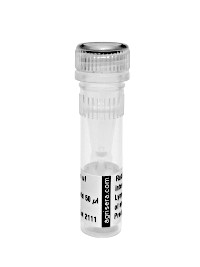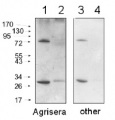1

Anti-RPN10 | 26S proteasome regulatory subunit RPN10
AS19 4266 | Clonality: Polyclonal | Host: Rabbit | Reactivity: Arabidopsis thaliana
- Product Info
-
Immunogen: HIS-tagged RPN10 of Arabidopsis thaliana UniProt: P55034-1, TAIR: At4g38630 expressed in E. coli and purified by metal-chelate affinity chromatography Host: Rabbit
Clonality: Polyclonal Purity: Serum Format: Lyophilized Quantity: 50 µl Reconstitution: For reconstitution add 50 µl, of sterile water Storage: Store lyophilized/reconstituted at -20°C (short tem, months) or at -80°C (long term, years) ; once reconstituted make aliquots to avoid repeated freeze-thaw cycles. Please remember to spin the tubes briefly prior to opening them to avoid any losses that might occur from material adhering to the cap or sides of the tube. Tested applications: Western blot (WB) Recommended dilution: 1 : 3000 (WB) Expected | apparent MW: 40.7 | 40 kDa - Reactivity
-
Confirmed reactivity: Arabidopsis thaliana Predicted reactivity: Gossypium hirsutum, Noccaea caerulescens, Theobroma cacao
Species of your interest not listed? Contact usNot reactive in: No confirmed exceptions from predicted reactivity are currently known - Additional Information
-
Additional information (application): For Western blot detection image, please check van Nocker et al. (1996). - Background
-
Background: RPN10 (26S proteasome regulatory subunit RPN10) is playing a role in maintaining the structural integrity of the 19S regulatory particle (RP), subcomplex of the 26S proteasome by the direct and indirect recognition of ubiquitinated substrates of ubiquitin/26S proteasome-mediated proteolysis (UPP). Binds and presumably selects ubiquitin-conjugates for destruction. Plays a role in the growth and development via the proteasome-dependent degradation of the ABA-signaling protein ABI5/DPBF1 and in the balancing cell expansion with cell proliferation rates during shoot development.
Alternative names: 26S proteasome non-ATPase regulatory subunit 4 homolog, AtRPN10, 26S proteasome regulatory subunit S5A homolog, Multiubiquitin chain-binding protein 1, AtMCB1, MBP1. - Product Citations
-
Selected references: Xie et al. (2024). Proteasome resides in and dismantles plant heat stress granules constitutively. Mol Cell. 2024 Sep 5;84(17):3320-3335.e7. doi: 10.1016/j.molcel.2024.07.033.
Mu et al. (2024). Plastid HSP90C C-terminal extension region
plays a regulatory role in chaperone activity and client binding.Plant J. 2024 Jul 5.doi: 10.1111/tpj.16917.
Huang et al (2021). Parasitic modulation of host development by ubiquitin-independent protein degradation. Cell. 2021 Sep 30;184(20):5201-5214.e12. doi: 10.1016/j.cell.2021.08.029. Epub 2021 Sep 17. PMID: 34536345; PMCID: PMC8525514.
van Nocker et al. (1996). Arabidopsis MBP1 gene encodes a conserved ubiquitin recognition component of the 26S proteasome. Proc Natl Acad Sci U S A. 1996 Jan 23;93(2):856-60. - Protocols
-
Agrisera Western Blot protocol and video tutorials
Protocols to work with plant and algal protein extracts
Oxygenic photosynthesis poster by prof. Govindjee and Dr. Shevela
Z-scheme of photosynthetic electron transport by prof. Govindjee and Dr. Björn and Dr. Shevela - Reviews:
-
This product doesn't have any reviews.



